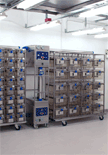
Biosafety
Introduction to Biosafety
Work with pathogens, clinical samples and naturally occurring or recombinant biological materials are an integral and essential part of research and development at Hong Kong University (HKU). We take great care to ensure that all procedures carried out in the university are conducted in such a way as to protect human health and the environment. This safe working with biological agents is often termed biosafety.
Our biosafety policy gives broad guidance for managing risk to human health or the environment resulting from activities involving biological agents. It applies to the use of all types of biological agents, including recombinant organisms, and covers the generation, transport, inactivation and safe disposal of any potentially infectious material. A set of more detailed guidance notes on specific issues are also available. These university standards are based on internationally established practice and compliance with them is verified through regular biosafety audits on all departments conducting biological activities.
The biosafety committee oversees the safe use of biological agents in the university. It is a sub-committee of the main university safety, health and environment committee and is comprised of a number of experts in relevant fields of work. Details of the approved terms of reference, composition and mode of action can be found here.


-
Guidance on Working with Viruses and Virus Vectors:
-
Guidance on GM Work:
-
Risk Assessment Forms:
-
RA1 (for general work with Pathogens)
-
RA3 (for work with Lentivirus-derived vectors and other Retroviruses)
-
RA4 (for work with Adenovirus)
-
RA5 (for work with Poxviruses)
-
GMRA (for work with AAV)
-
GMRA (for general GM risk assessment)
-
Clinical (for work with clinical samples)
-
-
Further Biosafety Guidance:
-
Environmental Samples: Biological Risks and Cleanup Procedures
-
Biological Safety Cabinets
-
Guidance on Decontamination
-
Guidance on Working with Cell Cultures
-
Guidance on Working with Naked DNA or RNA (includes Oncogenes, siRNA, etc.)
-
Health and Safety Information for Workers with Animals
-
Management of Needle Stick Injury, Bites, Scratches, Splashes or Mucosal Contact with Blood, Body Fluids or other Cinical Material
-
Risk Assessment for Work with Infectious Agents and Clinical Samples
-
Transport of Biological Materials between Laboratories and Sites
-
Work with Potentially Infectious Samples including Blood, Blood Products, Human Tissues and other Cinical Specimens
-
-
Introductory Biosafety Course (2018):
